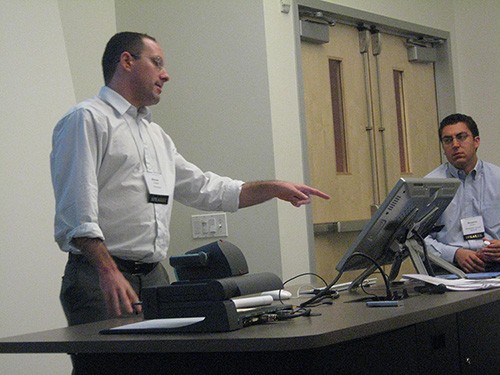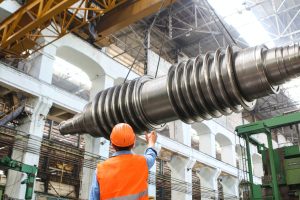In four feature stories and 22 follow-up articles, Michael Grabell, an investigative reporter at ProPublica, brought the safety of temporary workers into the spotlight. His research found that in California, Florida, Massachusetts, Oregon, and Minnesota, representing more than a fifth of the U.S. population, temporary workers are hurt at rates as high as six times that of regular employees.
Grabell and a ProPublica research team spent months delving into millions of temp workers’ compensation claims and interviewing more than 100 of them across the nation.
Their project won this year’s gold prize in the Barlett & Steele Awards for Investigative Business Journalism, sponsored by the Reynolds Center. As the judges said, the package “was terrific, with lots of data reporting but also very powerful human reporting as well. The logic of what led to the problems – companies avoiding the expense of full-time workers – provides a sad tale about the evolution of our economy.”
Grabell spent five years at the Dallas Morning News and has been at ProPublica for six years. He spoke to us about his experiences covering this story, which he continues to report.
1. The temporary workers story has been reported by other news organizations. Why did you pick it up and decide to look deeper into it?
I became interested in this issue through some work I was doing on the federal stimulus package, and through hearing from workers who had been laid off from factory and construction jobs and found out that the only thing available for them was temp work.
There had been some other stories about temp workers getting hurt on their jobs, and each time the temp agency’s response was, ” Well, that’s just one injury, there’s no trend here.” So I said, “we need to get the data and see what it really shows.”
The federal government doesn’t have any statistics on this, but I figured out a way. There had been an academic study in Washington State that had found that temp workers were like twice more likely to be injured on the same type of work as other workers. And so I said, can we replicate what they did in other states around the country and show that this is, without a doubt, happening.
2. An investigative piece like this needs a lot of tracking down. What part was the most difficult? How did you manage?
The hardest person to get on the record was a raitero, (the Spanish word for) a labor broker who drums up a workforce every morning for the temp agency and the company, and drives workers to the workplace. I would hear these crazy stories from temp workers about how they were tied to gangs, and how afraid they were of those raiteros.
I wanted to get these people on the record. I had gone back to Chicago multiple times, and, after several failed attempts, I finally knocked open one raitero’s door. We sat down, and he told me the story of how he became a raitero and what the job was really like.
The raitero feared he might lose his job ,but I convinced him that he was telling a side of the story. It would be far better to be able to understand who he was as a human being and what his motivations were than to go with what people would tell me about him. Eventually, he agreed to talk on the record and what comes would come.
3. Your investigation into temp worker safety involves big companies like Bacardi and others. Did you meet any resistance from their side? How did you deal with it?
For this, I never got a sit-down interview with any of the people in those big companies who would respond directly to it. But you should never give up making the call. I got names of the direct supervisors at the Bacardi plant in documents prepared by Occupational Safety and Health Administration (OSHA). I was ignored repeatedly on calls made to them, but finally I reached somebody on their cellphone.
I don’t expect people to come forward to tell me everything. Before somebody tells me that s/he doesn’t want to talk, I would say to them, “Don’t talk to me, just let me tell you what I’m going to write about you, so that you don’t pick it up one day and feel like you didn’t get a fair chance.” Sometimes they do respond, other times – like in this story – the person didn’t. That was the tensest interview I did for this project.
4. Apart from the four main feature stories, you and your colleagues wrote a total of 22 follow-up stories touching the legislative aspect of the issue. How important it is to follow up?
The first big story was published on April, 2013, and the last was published on February, 2014. They were spaced out by a few months. In between we did follow-up stories. One of the things I would say to other journalists is that you never know which story is going to create the impact.
After I had done the fourth story, I heard of the story of a man being buried alive in sugar at the CSC Sugar Plant in Pennsylvania. A safety device was removed just 13 days earlier, which could have saved his life, because a manager believed it was slowing down the production.
It bothered me a lot. I didn’t necessarily have to do it because I had written something similar, but eventually we did the story as a stand-alone piece. Next day I got a call from a senator’s office in Pennsylvania, asking questions about the story and saying that they were going to write a letter to OSHA to find out what’s going on with temp worker safety. It was this follow-up story that finally got someone in the U.S. Congress to care about it publicly.
5. You worked for the New York Times, the Dallas Morning News and now the ProPublica. Why did you join each of them? And how do you think the culture of the three differ from each other?
I did a six-month internship at the NYT when in college. I heard about it, thought it was cool, and then joined. After that, I got an internship with the DMN, and that’s where I got hired on and worked for about five years, did different beats, and ultimately served for its investigative team. Then I went to ProPublica, which is all investigative.
In ProPublica, there is luxury for reporters to work on a project for six months to a year, while in Dallas, there is always sort of breaking news versus investigative news… How do you fit the time of doing an investigative story into your regular work? I did breaking news for the DMN, but on the back burner I was always simultaneously trying to chip away at something bigger.
Another difference I would say is that… at the DMN most of my stories started from the ground up, expanding from breaking news into an investigative piece. At ProPublica, we don’t have breaking news that dictates the stories, so we start from 35,000 feeds and narrow them down to a topic to pursue and then to the specific story of the person to cover. It’s not 30 different reporters doing 30 different things on their own.
See a video from Monday night’s Barlett & Steele Awards conversation.











